UZBEKISTAN
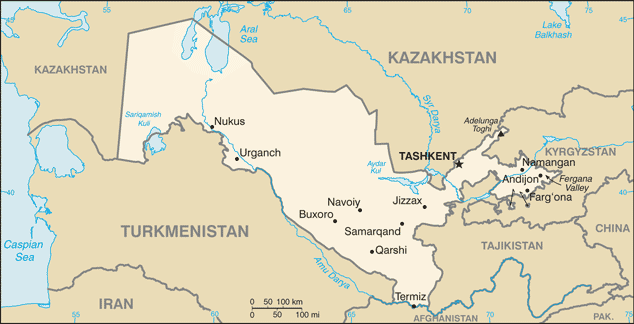
Uzbekistan is the only country in Central Asia which borders on all the others. It is also the most populous, with 24 million people, the ethnically diverse, with 150 different nationalities living in the big united family where there is full freedom of religion. Islam, Christianity, Jewish and Buddhist minorities coexist with full harmony.
The independent Uzbekistan that has emerged from the wreckage of the Soviet Union is the country where the best tradition is its hospitality. Everyone, irregardless of position is always treated as if he has been sent by God. Uzbeks like meeting people, communicate with others and interact between themselves. Meanwhile, Uzbekistan's extraordinary past, and the way that keeps resurfacing in the present, make it the most engrossing of the independent Central Asian countries.
Our agency offers the hospitality service in the style of the national house. What does that mean? The traditional national Uzbek house of the end of the XlXth century and the beginning of the XXth century is a picturesque product of the local master -architectures creative work. The main goal of the masters was the creations of such housing conditions which can be the most comfortable. Various planning methods suggested were oriented to maximum possible usage of the inner yard area, increase of the summer housing structure, provide the effective thermoregulation in dwelling space, improve the aesthetic qualities of the house.
The national dwellings were constructed from the local materials wood and clay was used for brick earth and burnt brick as well as for facing decorative works. The basic wall structure is made of wooden fan tracery as a rule of local poplar frees. Shutters, doors and trellis were made of the firm sorts of wood like plane-tree, nut-tree and elm-tree. The dwelling houses are faces to the pavement or spread along the street by its long wall. The entrance is located at one of the yard corners and lead through the short passage to the yard.
The yard is the basic structure of the house, there are two of them - the inner dwelling (or living) yard and the outer-visitor's yard. The buildings are grounded around the yard, with its center being free. Formation of the yard space is done by the whole complex of the surrounding buildings divided into winter place of communication and rest in Central Asia, the oasis on the very hot summer days and month called "Saraton" which meant 40 days the old mulberry tree grows, aged not less than 150 years. The visitors can find the shelter under its bushes and after dinner rest. The basement of the house is turned into nice, comfortable bar which presents the tourists the cool atmosphere of +250 while in the street it is +40 O above zero.
SAMARKAND
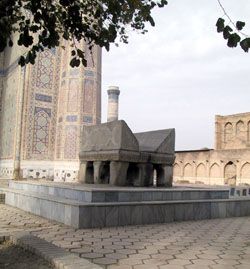
Samarkand, the capital of ancient Sogdiana, is one of the oldest cities in the world, of the same age as Rome, Athens and Babylon. It is twenty-five centuries old. During those centuries the city has survived many great and dramatic events. Samarkand saw Saka and Massagets, Greeks and Macedonians, Karakitais, Arab commanders and hordes of Genghis Khan. Under Amir Timur's governing Samarkand became the capital of his huge empire. The Great Silk Road went through the city. Famous scientists and poets of the Medieval Orient lived and worked in Samarkand.
Its geographical location in the picturesque valley of the Zerafshan River gave Samarkand (formerly also known as Maracanda) an advantage over other cities of Central Asia.
The exact antiquity of Samarkand is hard to establish. Originally Samarkand occupied the Mount of Afrosiab that rises to the north of modern Samarkand. The city grew and expanded its borders. It was one of the flourishing satrapies of the Achaemenid Empire from about 6th century BC. Alexander the Great led his marching armies in 325 BC to assert his claim over the lost provinces of the Achaemenids. It took him quite a while to quell the Sogdian rebellion. Passing through the remnant of Hellenic Dynasties, Samarkand was captured by the Sassanids under whom the arts and crafts flourished.
After the invasion of Arabs in the 8th century AD a new era of Samarkand began. The Arab assimilation with the local population gave rise to various new Muslim dynasties, the Samanids, Karakhanids, Seljukids and Genghisids. When the Mongols captured Samarkand the ancient water supply system was destroyed, and the life in the city collapsed. It took a whole century to recover from the after-effects of the Mongol invasion. The plundered and destroyed Samarkand was rebuilt on the site of one of its former suburbs.
During the reign of Amir Timur (Tamerlane) Samarkand enjoyed its best times serving as the capital. Tamerlane's successive campaigns to Persia brought master craftsmen and builders to the area, who contributed to the glorious era when Samarkand was beheld bedecked with the most beautiful of monuments in the form of mosques, madrasahs, gardens and mausoleums. According to Timur's idea, Samarkand was intended to overshadow all capitals of the world by its grandeur and beauty.
The grandson of Tamerlane, Ulugbek, ruled there until 1449 and made Samarkand the intellectual centre. However, the rise of nomadic Uzbeks spelt the end of Timurid power and Samarkand's prosperity. When the Uzbek Shaybanids moved their capital to Bukhara, Samarkand was left doomed to decline until the Bukhara Emir repopulated it in the 1770s.
In May 1868 Russian Tsarist army overtook the city and Samarkand was linked to the Russian Empire. In 1924-1930 Samarkand was the capital of the Uzbek Soviet Socialist Republic.
BUKHARA
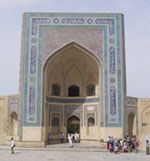
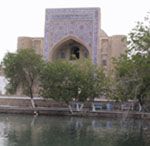
Bukhara is the city, which has been growing constantly at one and the same place beginning from the 4th century BC. Bukhara preserves treasures of architecture of the pre-Mongol period. The total number of monuments is above 400. Bukhara is regarded the largest open-air museum in Central Asia.
"Bukhara-I-Sharif" - "Noble", "Holy" is one of the numerous epithets that were bestowed on this ancient city.
The word Bukhara originates in Sanskrit from the word "vikhara", meaning monastery. It is said to have had the best of monastic establishments during its Buddhist days.
Narshaki wrote "The History of Bukhara" in the 10th century. It gave rise to a legend, which names Siavush to be the founder of Bukhara. Siavush, a son of a Persian Shah murdered by Afrosiab, a king of Turan, was worshipped in antiquity as a god.
Archaeological researches and evidences of ancient authors testify that it existed already in the 5th millennium BC, when the tribes of hunters and fishermen came to live in the lower reaches of the Zerafshan river.
In later history, the territory of Bukhara was a part of Achaemenid Persia, Alexander the Great Empire, the Seleucid domain, the Greek-Bactrian kingdom, the Kushan empire and the Ephtalites state, the Turkic kaganate, the Arabic caliphate, the empires of Jenghis Khan and Timurids, the Shaybanid state.
The much known history of Bukhara begins with the arrival of Arabs in the 8th century AD. After the settling of Arabs and subsequent conversion of its indigenous population to Islam Bukhara took a new turn when the local dynasties were established. During the rule of Samanids in the 9th century it was the best time for Bukhara. Later Bukhara fell to the Karakhanids and then to the rule of Khorezmshahs that is regarded as the era of great merits in arts and crafts. This was the time when great scholars like Avicenna, Al-Beruni and Narshaki contributed to the advancement of sciences and literature.
The invasion of Genghis Khan's Mongol hordes greatly destroyed the city and all aspects of life were disturbed for a long time. It was only during the later Genghisids and the Timurid dynasty that the city once again raised to its prominence. After a long series of wars and battles between the later Timurids in the 16th century it became the place of reign of the Shaybanids, which lasted for a long time.
Under the Astarkhanid dynasty (17th century), the Silk Road's decline slowly pushed Bukhara out of the mainstream.In 1740 the Persian King Nadir Shah conquered Bukhara. He left a local lord Muhammad Rahim as a governor in Bukhara. The governor proclaimed himself emir and founded the dynasty of Mangits.
It was the darkest period in the history of Bukhara. This dynasty ruled up to 1920 until the Bolsheviks came. The constant decay in ruling systems of Bukhara invited once again the foreign dominance with the result that the last emir had to run for his life's sake to the neighboring country.
In 60-70s of the 19th century Russia conquered Bukhara. Emir's army was weak and was not ready to fight against the Russians. In 1868 the army of Bukhara was defeated. Due to emir's desire, a peaceful treaty was signed, and Bukharan Khanate became the vassalage of Russia.
KHIVA
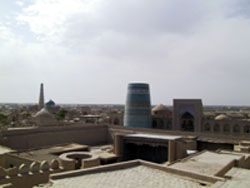
In the north-western part of Uzbekistan, on the left bank of the Amu-Darya River, in the transition zone between the sultry deserts of Karakum and Kyzylkum lie the lands of ancient Khorezm oasis.
Khiva is an ancient city in the lower reaches of the Amu-Darya River. Khorezm's agriculture and settlements go back to four, perhaps six, millennia. So, Khiva may be very old. The legend holds that it was founded when biblical Shem, the son of Noah, discovered a well here; the people called it Kheivak, from which the name Khiva is said to have originated.
But the archaeological data proves that the city already existed as early as the 6th -8th century. First it appeared as a stopping place and later as a caravan-saroi on the ancient trade road to the Caspian Sea and the Volga River. But while Khorezm prospered on and off from the 10th to the 14th centuries, its capital was at old Urgench (Kunya-Urgench). The changing moods of the Amu-Darya compelled the population of Kunya-Urgench to move to a more safer and habitable place and there was none but Khiva. In the 14th century it appeared prominent among the towns of Khorezm. It became the capital of Khorezm in the 16th century (the later more appropriately known as the Khanate of Khiva). For a very long time the local rulers were fighting against the tribal incursions from the neighbouring lands. The early years of the Khanate were racked by instability, infighting and invasion. In 1740 Khiva was wrecked by Nadir Shah, and Khorezm became for a while a northern outpost of the Persian Empire.
By the end of the 18th century it began taking a small share in the growing trade between Russia and the Bukhara and Kokand Khanates. Khiva had a slave market, the biggest in Central Asia. At the beginning of the 19th century Khiva developed into a prominent cultural centre. The Khanate spread from the Aral Sea to Merv. Expansionist Russian policy always threatened the very existence of Khiva, which was finally taken over in 1873. The enfeebled Khanate struggled on. However, the Khanate was fast approaching the end of its life and in 1920 the "Khorezm People's Republic" was proclaimed in its place. In 1922 the region gained promotion to a Soviet Republic and in 1924 joined the Soviet Union as a part of Uzbek Soviet Socialist Republic.
TASHKENT
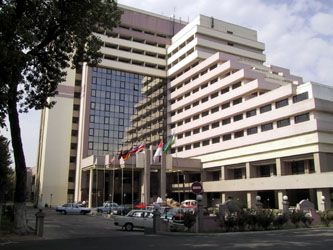
Tashkent is the capital of Uzbekistan and the largest economic and cultural centre of the country. At various stages of its long history, Tashkent was known as Shash, Chachkent, Shashkent and Binket. The name "Tashkent" is first mentioned in the works of Abu-Raikhon Beruni and Mahmud Kashgari (11th century). Tashkent is the Uzbek word for "stone town". How can we explain this name if in the construction of the city stone was rarely used? It was the hardness of the inhabitants more than once protecting their city from attacks of invaders that was compared by local people with a stone.
The territory of Tashkent makes up 260 square km. Tashkent is located in the north-east of Uzbekistan, in the picturesque valley of the Chirchik River which takes its source from the spurs of the Tian-Shan, at the height of 440-480 metres above the sea level. In clear weather snowy peaks of the Tian-Shan Mountains are visible. More than 2.3 million reside in the capital (approximately, 10% of population of the country).
The architecture of Tashkent is characterised by the mixture of modern and traditional styles of buildings. There is a green city with lots of fountains and parks. The vicinities of present day Tashkent record their chronology back to the 5th century BC.
It passed through successive hands of numerous ruling clans. Its vivid record is mentioned through the 7th century AD from the Scythians, the Sassanids and the Ephtalites.
A more authentic picture of Tashkent was drawn with the invasion of Arabs in the 8th century. The city grew into an important trading post on the Great Silk Road, from China to the Mediterranean countries, when it was busting with commerce. As it was described in the annals there had been beautiful palaces among green gardens, temples and streets of craftsmen. In the capital craftsmen were engaged in metal processing, weaving cotton and woollen clothes, manufacturing of weapons, ceramics, jewellery.
It saw different dynasties of rules of which the prominent were the Samanids in the 9th century and the Karakhanids in the 10th - 11th centuries. The invasion of the Mongol hordes in the 13th century brought a short delay in the development of Tashkent. This continued until history reverted to the turbulent path of the later Genghisids and the grand Timurid dynasties (the 14th - 15th centuries) when Tashkent got its importance of a strong fortress. Its territory was extended, manufacture, trade, culture developed.
In the 16th century the city was once more ransacked by an invader from the north - Shaybanid Khan, leader of the nomadic Uzbek Turks, who were to give their name to the whole region. Tashkent adapted to this new ruler and built up its wealth again. The city was a part of the State of Shaybanids as an independent principality of one of them, Suyunidj khan. During this period extensive building work was carried out. Monumental buildings as mausoleums, mosques, madrasahs appeared.
In the next centuries there were three states on the territory of Central Asia: the Bukhara Emirate, the Khiva and Kokand Khanates. Tashkent passed from hand to hand, from one khanate to another. In the second half of the 18th century Tashkent was attached to the Bukhara Khanate. In the early 19th century the Khan of Kokand conquered city. At that time due to growing commerce with Russia Tashkent turned into a prosperous trading city, one of the largest cities in the region.
In the 19th century Tashkent was a Central Asian centre of trade with Russia. Looking for new markets, the Russians regarded Tashkent as the strategic key to Central Asia. In 1865 the Tsarist army captured Tashkent and the city as well as all Turkestan became the constituent of the Russian Empire. In 1867 the Governorate General of Turkestan with the administrative centre in Tashkent was formed. At the end of the 19th century Tashkent was roughly divided into an old Asian and new Russian towns. After the Bolshevik revolution in 1918 the Republic of Turkestan was proclaimed. In 1930 Tashkent became the capital of the Uzbek Soviet Socialist Republic. Since 1991 Tashkent is the capital of Independent Republic of Uzbekistan.
FERGHANA VALLEY
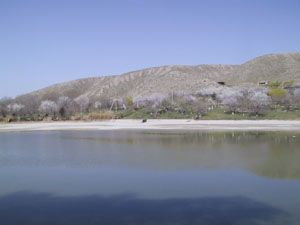
The heartland of Uzbekistan, as the valley of Ferghana is known, is the densely populated part of the country with a majority of ethnic Uzbeks. Ferghana is the most fertile part of Uzbekistan, with large agricultural output. The Chatkal range of the Tian Shan in the north surrounds the valley, with the Pamir-Alai in the south from where the Syr Darya River starts flowing through the valley. So the region looks like a huge bowl. Ferghana valley is considered to be a big blossoming oasis of Central Asia. That's why Ferghana Valley is called "The Golden Valley".
The valley's best-known son is probably Zaheruddin Mohammad Babur (Timur's great-great-great grandson), the last Timurid and the first Moghul, the founder of India's Moghul Empire in the 16th century.
The valley of Ferghana was renown for its swift and intelligent horses, bred since ancient times. During the reign of emperor Wuti, Chinese are known to have sent several expeditions for acquiring the prized horses. The brisk trading on the Great Silk Road brought Ferghana into the limelight of history. The legions of Alexander the Great skirted the valley in the southern part and after subduing the land, he is said to have founded Alexandria Eskhata. Later on having withstood various ruling dynasties, the most flourishing period of the history of Ferghana opens with the settling of Mongol hordes grouped into various fiefdoms. The Khanate of Kokand became the base of powerful Uzbek clans with control as far as Yarkand in China. From the early 19th century, the Khanate of Kokand expanded for beyond Ferghana into Central Asia's third power. The powerful Khanate crumbled under the weight of its mismanagement with the Russians giving the final blow when it was incorporated into the territories of Tsarist Russia. The cities of the Ferghana valley were taken by the Tsar's troops in 1876 with little effort and the Khanate was dissolved.
The Bolsheviks succeeded Tsarist colonisation in 1924.
The overall territory of Ferghana Valley is 77,900 square km with the population of 9 million people.
The valley of Ferghana is a home for several historical towns as follows:
Margilan: it is known for the best of Silk factory- Yodgorlik weaving the traditional methods.
Rishtan: is the pottery town for the traditional blue glazed floral designs.
Andijan: the city of Babur, his birthplace -the museum and house of Ark Icchi and the grand bazaar of Andijan.
Kokand: is the seat of Khanate - Palace of the last ruler Khudayar Khan.

| Login form |
| Menu |
|
|
| Airline ads |
| Calendar and clock | |||||||||||||||||||||||||||||||||||||||||||||
| |||||||||||||||||||||||||||||||||||||||||||||
| Samarkand photos |
| Currency rate & Stats |
